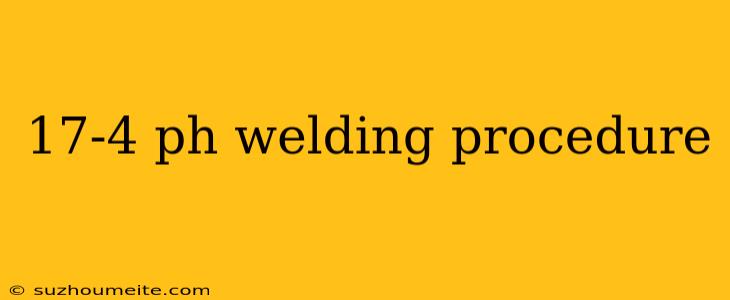17-4 PH Welding Procedure
Introduction
17-4 PH is a type of precipitation-hardened stainless steel alloy that is widely used in various industries, including aerospace, chemical processing, and power generation. Its unique combination of high strength, corrosion resistance, and weldability makes it an ideal material for fabricating complex components. However, welding 17-4 PH requires a thorough understanding of its properties and a well-planned welding procedure to ensure high-quality welds.
Welding Process
The welding process for 17-4 PH typically involves gas tungsten arc welding (GTAW) or gas metal arc welding (GMAW). GTAW is preferred for its ability to produce high-quality welds with minimal heat input, while GMAW is used for thicker sections and higher deposition rates.
GTAW (Gas Tungsten Arc Welding)
- Equipment:
- GTAW torch with a tungsten electrode (2% thoriated or ceriated)
- Argon or argon-helium shielding gas
- Welding power source with pulse capability
- Parameters:
- Current: 50-150 amps
- Voltage: 10-15 volts
- Travel speed: 2-5 inches per minute
- Shielding gas flow: 10-20 cubic feet per hour
GMAW (Gas Metal Arc Welding)
- Equipment:
- GMAW gun with a solid wire electrode (ER308L or ER309L)
- Argon or argon-CO2 shielding gas
- Welding power source with pulse capability
- Parameters:
- Current: 100-250 amps
- Voltage: 18-28 volts
- Travel speed: 5-10 inches per minute
- Shielding gas flow: 20-30 cubic feet per hour
Preheat and Interpass Temperature
To prevent cracking and ensure weld quality, it is essential to maintain a controlled preheat and interpass temperature during the welding process.
- Preheat: 200°F to 300°F (90°C to 150°C)
- Interpass: 200°F to 300°F (90°C to 150°C)
Welding Techniques
Backstep Welding
This technique involves welding in a backstep pattern to minimize the heat input and prevent overheating.
Push Angle
A push angle of 10° to 15° is recommended to ensure proper fusion and minimize lack of fusion defects.
Weld Layers
Multiple weld layers may be required to build up the desired thickness. Each layer should be allowed to cool to the interpass temperature before applying the next layer.
Post-Weld Heat Treatment
17-4 PH weldments require a post-weld heat treatment (PWHT) to relieve stresses and restore the material's corrosion resistance.
- Temperature: 1050°F to 1150°F (566°C to 621°C)
- Time: 1 to 2 hours
- Cooling: Slow cooling in a furnace or air cooling
Conclusion
Welding 17-4 PH requires a thorough understanding of its properties and a well-planned welding procedure. By following the guidelines outlined in this article, welders can produce high-quality welds that meet the required specifications. Remember to always follow safety protocols and use proper welding techniques to avoid defects and ensure the integrity of the weldment.
